

ALGIZ 10X improves order fulfillment at 150,000-square-meter warehouse
NAUTIZ X8 provides communication and navigation support for glacier explorer
Fast, discreet radiation monitoring — Inconspicuous NAUTIZ X8 makes it easy
Timber buyers increase accuracy, efficiency and profits with rugged handhelds
Algiz 10X emergency response system improves efficiency for ambulance workers
Nautiz X3 helps meat distribution company improve quality control in refrigerated storage facilities
Nautiz X8 helps GIS professionals calculate utility pole measurements
Great Lake Energy uses Algiz 7 computers used in SHESH project
Algiz 10X computers used in telemedicine case
Nautiz X4 computers improve logistics and cargo monitoring for a Scandinavian transport company
Handheld CEO: Rugged computers a game-changer in critical field rescue situations
Handheld CEO: Rugged Computing Key Trends in 2015
Handheld CEO: Rugged Computers Are More Than Just 'Hard Shells'
Handheld CEO: The Trend Towards 'Ruggedish' Computers and Smartphones
Technology for Technicians: 2013 Trends
Handheld CEO: How to Purchase Mobile Computers Wisely
Case Study: Computers in Diving and Marine Exploration
Handheld Group Business Partner Conference 2010, Stockholm
|

|

|
|
Handheld Algiz RT10
Ultra-rugged Android tablet provides high performance and ample display space for productivity in demanding environments
(by Conrad H. Blickenstorfer; Photography by Carol Cotton; for brief capsule review, see here)
Share on:



Swedish Handheld Group announced the Android 11-based 10-inch Algiz RT10 September 2022 as a new addition to the company's lineup of rugged handhelds and tablets for field workers in all sorts of demanding environments. Compact, light and handy, the Algiz RT10 competes in the increasingly important segment of fully rugged 10-inch Android tablets. RuggedPCReview has taken a detailed look at the Algiz RT10, what it brings to the table, how well it performs, and how it fits into the overall segment landscape.
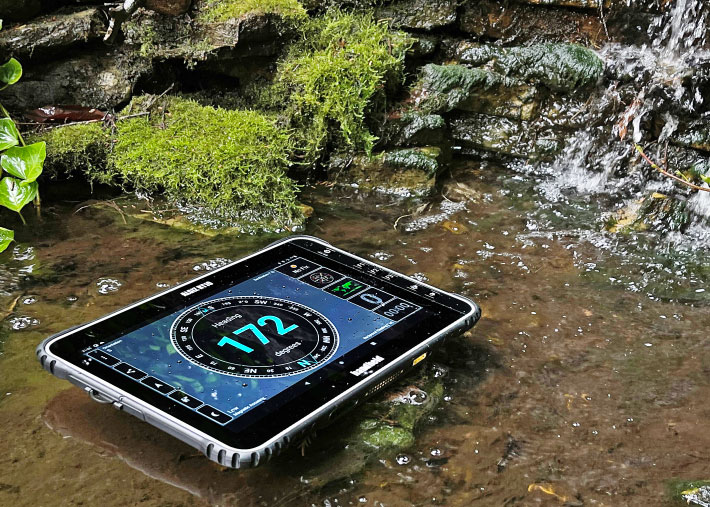
Handheld, which since September 2022 is part of MilDef Group, offers two primary product lines, those being the "Nautiz" branded rugged handhelds and the "Algiz" branded rugged tablets. Formerly based on the Microsoft now defunct Windows Embedded Handheld operating environment, all Nautiz handhelds are now running Android. In contrast, on the Algiz tablet side Handheld supports both Android and (full) Microsoft Windows. With the new Algiz RT10, the company now offers three tablets running Windows and two running Android. The image below shows Handheld's current (as of November 2022) tablet lineup.
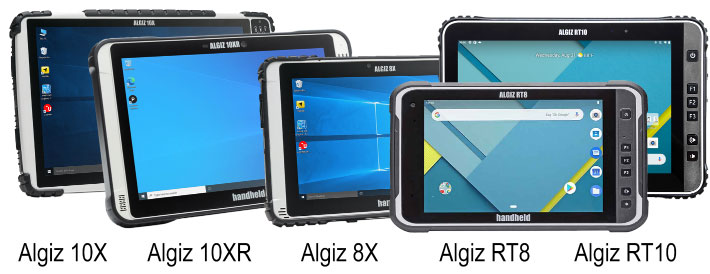
Contemplating the new Algiz RT10, let's start with answering some basic questions first. Why a rugged 10-inch Android tablet when Handheld already has a very nice rugged 10-inch Windows tablet in the Algiz 10X?
It's because Android is becoming more and more important in rugged tablets as well. All Tier 1 vendors of rugged mobile computers now offer 10-inch tablets. And with inclement weather outdoors and often the need to wear gloves, many users find a bigger display easier and more pleasant to use. With the new Algiz RT10, Handheld now has as a larger and more powerful complement to the still available 8-inch Algiz RT8.
Also, consider that while the overall global smartphone market is dominated by Android, the situation is less clear in tablets. That's in part because Google's focus with their Android OS is clearly on smartphones and almost all Android apps are designed and formatted for smartphones. As a result, both Windows and Android have a strong presence in tablets, with Windows generally seen on larger tablets and Android on smaller ones. That, however, is slowly changing now, with Android increasingly used in larger tablets as well.
Why size matters
Why do we consider truly functional rugged 10-inch tablets so important? To answer that we need to look into the past. When PCs first appeared four decades ago, the typical desktop display measured 11 inches diagonally. That's what the original IBM PC had, and it set the tone for years to come. But it wasn't enough for desktop work, and today's desktop screens are much larger.
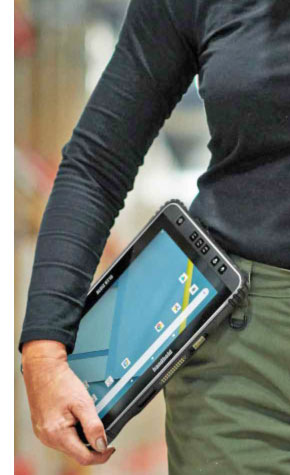 Desktops, however, are one thing and mobile devices another. When the first PDAs and little Windows CE devices emerged in the 1990s, neither were very successful. PDA screens then shrank down to 3.8 and even 3.5 inches, which worked for small connected organizers and communicators like the Palm Pilot and Blackberry devices. But by that time the web had emerged and handhelds faced a new challenge: how to get web content onto those little screens. There were mobile browsers but they barely worked. Desktops, however, are one thing and mobile devices another. When the first PDAs and little Windows CE devices emerged in the 1990s, neither were very successful. PDA screens then shrank down to 3.8 and even 3.5 inches, which worked for small connected organizers and communicators like the Palm Pilot and Blackberry devices. But by that time the web had emerged and handhelds faced a new challenge: how to get web content onto those little screens. There were mobile browsers but they barely worked.
That changed when Apple introduced the iPhone in 2007. Apps, and with them the iPhone, took off. Apps became more complex and so iPhone screens grew from their original 3.5 to as big as they are today. Steve Jobs, however, realized that there was something missing between the iPhone and the much bigger laptops, something better suited for browsing, reading, email, imaging, video, and true productivity apps.
The 9.7-inch iPad came in 2010. With more room than even the biggest phone, the iPad took off. By now, almost half a billion iPads have been sold, even though one could argue that iPads are just big phones. Yes, four or five iPhones are sold for every iPad, but last year that still amounted to about 60 million iPads. Why?
Because size matters. Even the biggest phone still needs to fit into a pocket. Pockets are only that wide, and so phones have gotten longer and longer, with aspect ratios of 20:9 and more. That works for apps conceivable, but often not for real work. Phones are optimized for hands and pockets. Tablets for real work. There is now an emerging generation of powerful, purpose-designed large screen rugged Android tablets for vertical and industrial markets. And the new Algiz RT10 is one of them. Android works very well on phones, but on a big 10-inch tablet it is a pleasure to use.
Display size matters. Different size screens work for different types of work. You can do almost anything on a phone these days. But it can be frustrating because the screens are just too small. On a tablet with a bigger screen, it all works and it all falls into place. The big names in rugged mobile tech have all recognized that and offer industrial-grade 10-inch Android tablets. Handheld now does, too.
What Handheld offers with the Algiz RT10
How did Handheld go about creating its new 10-inch tablet? They did it their way. Throughout Handheld's history, the company, more than almost anyone else, has had a consistent design language and consistent color schemes. Handheld devices have a visual brand recognition rivaled only by Panasonic Toughbook products. You know a Handheld device when you see one, and the Algiz RT10 is no different. Here's what customers get with the Algiz RT10:
- Excellent display — The Algiz RT10 display measures 10 inches diagonally and has full 1,920 x 1,200 pixel resolution. The 16:10 aspect ratio looks pleasing to the eye. It's not too boxy and not too wide. It works both in landscape and in portrait orientation. With 600 nits luminance, the Algiz RT10 screen is much brighter than your average laptop and can easily be used outdoors.
- Capacitive multi-touch — Virtually all handhelds and tablets use capacitive multi-touch now. On the Algiz RT10 it works as smoothly and responsively as users — spoiled by modern consumer smartphones and tablets — have come to expect. And the RT10's glove and rain modes make it that much better and easier to use outdoors.
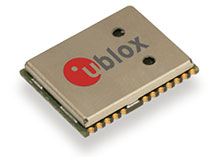 - Concurrent GNSS — For positioning, the Algiz RT10 uses a dedicated u-blox NEO-M8U module with support for all major global GNSS systems (GPS, GLONASS, Galileo, BeiDou, as well as QZSS and SBAS). That means the receiver can not only use the satellites of the United States' GPS, but also those of other nations' positioning systems. Having more satellites for determining position improves positioning accuracy under adverse conditions or in areas with poor coverage. If inch- or even centimeter-level accuracy is needed, Handheld also offers a special RTK version of the tablet, equipped with a u-blox ZED-F9P GNSS module and an active multi-band antenna.
- Android 11 GMS — The Algiz RT10 comes standard with the full GMS version of Android. GMS stands for Google Mobile Services, which means access to the Google app store and all of Google's popular productivity apps either installed or available for download. Handheld also includes its own enterprise-grade MaxGo configuration and staging manager software.
- Packs a punch — In the past, rugged Android tablets often used "compromise" processors that could run either Android or Windows, neither of which well. Handheld based the Algiz RT10 on the modern Qualcomm Snapdragon 480 octa-core processor that was introduced in 2021.
- Attractive look — The Handheld Group has long excelled in their styling sense and expertise, and the sleek new Algiz RT10 is no exception — it merges the contemporary flush glass look of consumer tablets with a tough, functional enclosure with function buttons.

Handheld has also had a knack of hitting the sweet spot between consumer tablet good looks and on-the-job ruggedness and functionality. The RT10 is a handsome looking piece of equipment, and one that, unlike modern consumer tablets, has enough of a bezel to protect the display and to be held and handled without the screen registering unintended touch. Like the smaller Algiz RT8, the Algiz RT10 has those actual physical, programmable buttons. On the job and under adverse conditions, buttons can be faster and more reliable than just touch.
The hardware
One look at the new Algiz RT10 says it all. Handheld clearly aced the design. But the Algiz RT10 is more than just a scaled-up version of the company's smaller Algiz RT8. While an 8-inch screen provides more room for Android apps than even the biggest phone, the Algiz RT10's 10-inch screen is bigger and better yet. By a lot; the 10-inch display of the Algiz RT10 has a full 89% more screen area than the 8-inch display of the Algiz RT8.
The Algiz RT10 measures 9.8 x 5.7 inches — pretty much the same as the primary 10-inch rugged Android tablet competition from Getac, Panasonic, RuggON and others. For a fully rugged device the Algiz RT10 is remarkably slender at 0.67 inches, and its 2.2 pounds is light enough to easily carry it around.
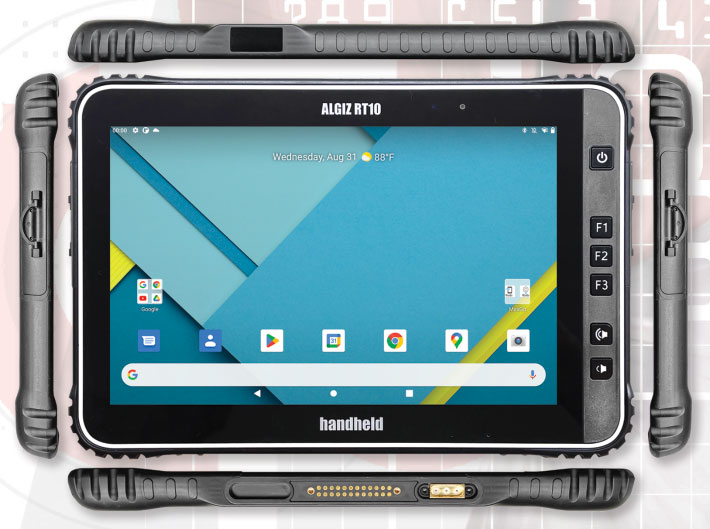
Whereas rugged Windows tablets usually have plenty of interface ports, Android tablets — and especially slender ones like the Algiz RT10 — generally make do with less. In this case a couple of USB 3.0 Type A ports, a reversible USB Type C port that's also used for charging, and a 3-1/2mm headphone jack. If more is needed, Handheld offers a vehicle dock with HDMI, RJ45 Ethernet, USB, antenna pass-through and more (see below).

The picture below shows, on the left, the backside of the Algiz 10 tablet with its battery compartment door in place and locked. Note the expansion connector for bolt-on modules besides the battery compartment. There is also the rear camera and flash, a speaker, and the tablet's fingerprint reader.
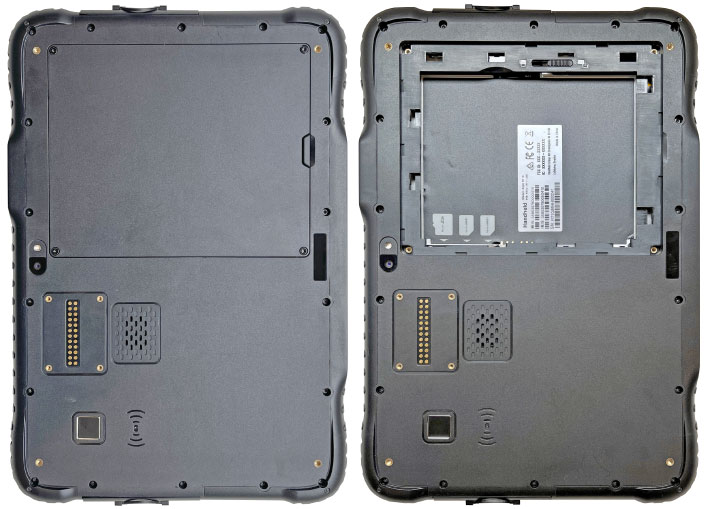
While most consumer tablets have internal batteries, the Algiz RT10 has an externally accessible replaceable battery. It's a 44.46 watt-hour (3.8V/11,700mAh) 4-1/2 x 3-5/16 x 3/16 inch rechargeable Li-Ion battery that sits in a compartment in the back of the tablet. 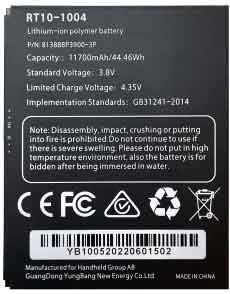 Unlike the battery in Handheld's Windows 10-based Algiz 8X where the battery is part of the design and there is no battery compartment cover, the Algiz RT10 battery does require a cover that has an orange silicone pressure seal around its entire perimeter. That cover is secured with four Torx T6 screws, so this design isn't meant for quick battery exchanges on the fly; you do need a screw driver. Unlike the battery in Handheld's Windows 10-based Algiz 8X where the battery is part of the design and there is no battery compartment cover, the Algiz RT10 battery does require a cover that has an orange silicone pressure seal around its entire perimeter. That cover is secured with four Torx T6 screws, so this design isn't meant for quick battery exchanges on the fly; you do need a screw driver.
Since the battery compartment is open to the inside of the tablet, it's crucial to examine the seal for nicks or other damage every time the cover is put back in place.
Inside the battery compartment you find the tablet's micro SDXC card slot that can handle cards up to 128GB, and next to it two nano-SIM slot.
As far as construction goes, the Handheld Algiz RT10 housing consists of a black polycarbonate plastic bucket-style back, and a front light-gray polycarbonate plastic assembly that fits into the back. The two parts are held together via about 20 small Torx T6 screws with tiny washers. Thankfully all the screws are of the same 1/16 size.
A tongue-and-groove rubber seal design keeps dust and moisture/liquids from penetrating. The tongue is hard plastic and part of the bottom half of the housing; the groove around the perimeter of the front part has a black replaceable rubber/silicone O-ring seal that's easy to see and easy to fit.
Once all the Torx screws holding the two parts of the housing together have been removed, you can carefully push the front part of the housing out of the rear bucket. Carefully, because there is a ribbon between the two halves that goes between the mother board and the display/touch connector. A second ribbon bridges the battery compartment cutout. Both of those sit underneath a thin black plastic sheet with labels for the card slots as well as the unit's identification label with all the requisite ID numbers and bar codes. That sheet is stuck onto front plate and must be removed before the two halves can be separated. A heat gun helps.
Another connection between the halves — the physical key activators — are handled via spring-loaded pogo pins. A good solution.
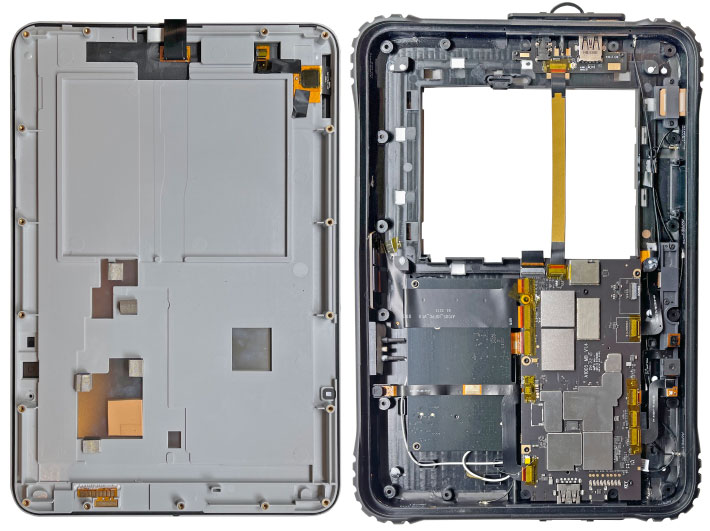
Once the halves are fully apart, the inherent difference between Windows and Android tablets becomes obvious: whereas Windows tablets usually have a miniaturized PC-style motherboard and plenty of components, the inside of Android tablets is similar to a smartphone. There is a very compact system board with most functionality integrated into chips, so there are few or no discrete modules. The Algiz RT10 does have a daughterboard, though, for the unit's USB Type-A port.
While many rugged tablets have internal metal frames to provide strength and a solid surface to mount electronics on, there's no such thing in the Algiz RT10. Just like the Algiz RT8, Handheld designed the Algiz RT10's slender polycarbonate housing rigid and strong enough to alleviate the need (and extra weight) for a metal chassis. Nor do ARM-based Android devices generate enough heat to require a fan or a metal frame or housing to help dissipate heat.

Technology and performance
What about performance? Here, while each new leading consumer smartphone has the very latest and fastest chip, rugged Android devices have generally been more conservative. That's because, as Handheld's CEO Thomas Löfblad once said, with rugged tablets the goal is to hit that perfect spot between value and efficiency. That makes sense.
For the new Algiz RT10, Handheld picked the Qualcomm Snapdragon 480, an octa-core processor  that was introduced in 2021. This chip should offer about twice the performance of the Snapdragon 625 used in Handheld's smaller Algiz RT8, and generally be as quick or quicker than the Snapdragon 660 that's currently found in most high-end rugged Android devices. Qualcomm describes the SD 480 as a 5G Mobile Platform that supports multiple 5G spectrums, dual-antenna Wi-Fi, and also includes the powerful Adreno 619 GPU. that was introduced in 2021. This chip should offer about twice the performance of the Snapdragon 625 used in Handheld's smaller Algiz RT8, and generally be as quick or quicker than the Snapdragon 660 that's currently found in most high-end rugged Android devices. Qualcomm describes the SD 480 as a 5G Mobile Platform that supports multiple 5G spectrums, dual-antenna Wi-Fi, and also includes the powerful Adreno 619 GPU.
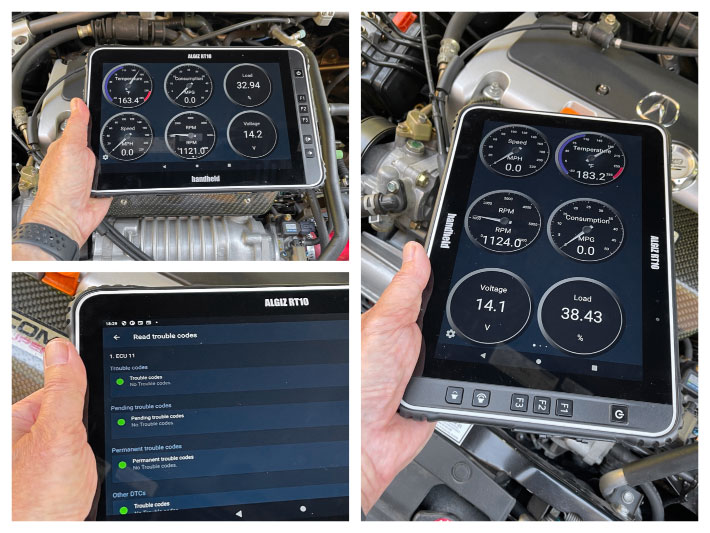
In our benchmark testing, the Handheld Algiz RT10 did well. It generally scored about twice as high as the smaller Handheld Algiz RT8, as one would expect from a newer device that, due to its larger display, will likely be used for more demanding applications. The Algiz RT10 also held its own against its Tier One competition from Getac and Panasonic, and exceeded them in some of the benchmarks. Note that in the rugged Android device segment, performance competition isn't (yet?) as heated as in rugged Windows tablets; the industry has more or less standardized around tried-and-true chips such as the Qualcomm SD660.
10-inch Rugged Android Tablets Benchmark Overview
|
|
PERFORMANCE COMPARISON
|
Handheld
|
Getac
|
JLT
|
Panasonic
|
RuggON
|
|
Model
|
Algiz RT10
|
ZX10
|
JLT6012A
|
Toughbook A3
|
SOL PX501
|
|
Product type
|
Fully rugged 10-inch tablet
|
Fully rugged 10-inch tablet
|
Rugged vehicle-mount
|
Fully rugged 10-inch tablet
|
Fully rugged 10-inch tablet
|
|
Year tested
|
2022
|
2022
|
2021
|
2020
|
2019
|
|
Processor Type
|
Qualcomm
|
Qualcomm
|
Qualcomm
|
Qualcomm
|
Qualcomm
|
|
Processor Type: Intel
|
SM4350
|
SD660
|
SD660
|
SD660
|
SD660
|
|
PCMark for Android
|
6,020
|
6,445
|
6,756
|
6,225
|
NA
|
|
PassMark Mobile
|
8,205
|
7,229
|
3,637
|
4,473
|
10,011
|
|
AnTuTu
|
246,923
|
182,516
|
182,979
|
172,458
|
162,015
|
|
Vellamo Browser
|
7,644
|
5,528
|
5,490
|
5,650
|
5,921
|
|
Vellamo Metal
|
4,117
|
3,299
|
3,064
|
2,954
|
2,858
|
|
Vellamo Multicore
|
3,230
|
3,235
|
3,302
|
3,513
|
3,840
|
|
Geekbench 5 Single
|
473
|
325
|
335
|
323
|
NA
|
|
Geekbench 5 Multi
|
1,509
|
1,454
|
1,635
|
1,412
|
NA
|
|
Geekbench Open CL
|
1087
|
636
|
634
|
NA
|
NA
|
|
Max Luminance
|
582 nits
|
765 nits
|
627 nits
|
1,120 nits
|
810 nits
|
As for other specs, there are 6GB of RAM, 128GB of internal storage (augmentable via a microSDXC card slot), two cameras (5mp and 13mp AF), 802.11ac WiFi and Bluetooth 5.1, 4G LTE and 5G, dual nano-SIMs.
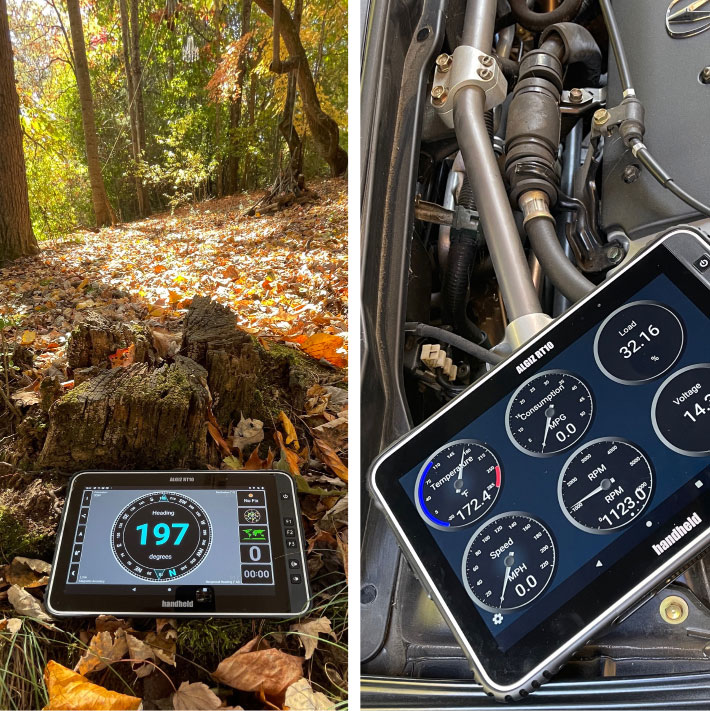
Function keys
As an Android-based capacitive multi-touch tablet, the Algiz RT10 doesn't have or need a physical keypad or buttons. However, there are times when having actual buttons comes in handy. Sometimes a quick button push works quicker and better than first locating and launching an app. Or it rains or you wear thick gloves.
For those kinds of situations the Algiz RT10 offers, in addition to the power button and the volume up and down buttons, three programmable function keys, F1, F2, and F3.

Assigning functions to them is done in Settings -- Advanced features -- Function key settings. This, however, seems limited to use the function keys to launch apps.
For use with ported Windows apps or terminal emulation screens that use PC-style functions keys, you'd need to be able to assign F1 through F12 and perhaps cursor control keys and such. Likewise, in order to take full advantage of the Algiz RT10's three physical function keys, it would have been nice to double the number of functions via short and long presses, but that is not available.
Cameras don't rival premium smartphones, but good enough
The Handheld Algiz RT10 has two cameras. The one facing the user has a 5-megapixel imager and is for video calling and conferencing. The rear-facing camera has auto-focus, a 13-megapixel imager, and an LED flash. Both can do still pictures and video. The rear camera can be used to visually document work status, progress, completion, etc. While virtually everyone carries a smartphone with good cameras these days, it may still be advantageous to record and store all data with one device rather than using multiple ones.
Cameras integrated into vertical and industrial market tablet computers have historically underperformed compared to dedicated cameras and, more recently, even more so compared to smartphone cameras with their sophisticated apps and features. Integrated cameras have improved substantially over the past few years, to the point where they were often good enough to eliminate the need of taking along a dedicated camera or smartphone if photo or video documentation was needed on the job.
Over the past two or three years, we've seen a leveling off of integrated camera quality and ease of use, as if manufacturers had decided that smartphones have became so pervasive and their cameras so good as to render cameras integrated into rugged tablets irrelevant.
Android systems, however, has always had much better integrated camera support than Windows-based computers, especially on the software side, and that applies to the cameras in the Algiz RT10 as well.

The Camera app in the Algiz RT10 is simple, intuitive and easy to use. Unlike the Windows Camera app that is extremely limited, the Algiz 10 camera app has scene settings, GPS location, face detection, a continuous shot mode, white balance modes, and over 20 images sizes in various aspect ratios. You can shoot pictures either in 4:3 or 16:9 format, and video in various resolutions. There is also a "ProMode" that enables a degree of manual control for ISO (100-3200), exposure (+/- 2EV), white balance (5 modes) and focus (macro to infinity).
Below are sample pictures shot with the Algiz RT10 rear camera in its highest resolution, which is 4160 x 3120 pixels in 4:3 aspect ratio format (click the image compilation for a full size version):

The documentation camera can shoot very serviceable 1080p video, and it, too, has some nice features. A time lapse mode allows shooting in intervals from half a second to 24 hours, there's video rotation, users can select audio (AMRNB or AAC) and video (MEG4, H264, H265) encoders, there's selectable noise reduction, and more.
The Algiz RT10's integrated cameras don't quite match the incredibly advanced and powerful cameras in today's premium smartphones, but they are good enough for the jobs intended. And don't underestimate to frame and then view images on a big 10-inch screen instead of a small smartphone display or, worse, the tiny display of a dedicated camera.
Bright and very good 10-inch display
The Algiz RT10 tablet's 10.0-inch display offers 1920 x 1200 pixel resolution, making for a pleasant 16:10 aspect ratio and a crisp 283 pixels per inch. That clearly qualifies for "retina" sharpness and quality in the sense that you don't see individual pixels from the typical viewing distance.
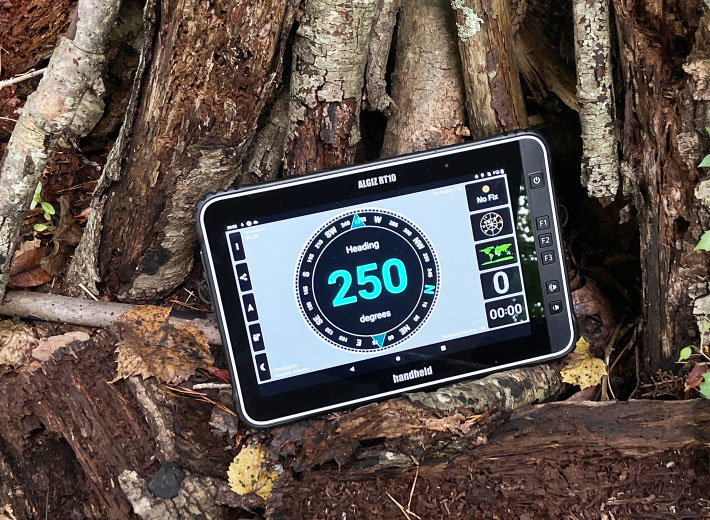
The 10-inch diagonal LCD size is, in our opinion, the perfect size for a mobile tablet — not too small and not too large. It provides much more viewing area than even the largest of today's big smartphones. That makes working on this screen so much more pleasant, especially with navigation, positioning and complex apps. The Algiz RT10, however, also is and feels a LOT larger than even the biggest smartphone, in part due to the generous margin around its display and in part because of the physical function key area. The flush glass bezel area around the actual LCD display makes the Algiz RT10 easy to hold and work with it, without the inadvertent triggering of touch actions that's such a nuisance in "wrap-around" screen smartphones. How does the Algiz RT10 compare in resolution with its Algiz 10X Windows-based sibling? No difference there. Not like in Handheld's 8-inch class tablets where the Android-based Algiz RT8 has more than twice as many pixels than the Windows-based Algiz 8X.
 That said, resolution alone isn't everything, especially not with displays that are often, or predominantly, used outdoors and in broad daylight. It's one thing for a display to look good indoors, and quite another doing so outdoors with its much higher brightness, the sun, and reflections everywhere. That said, resolution alone isn't everything, especially not with displays that are often, or predominantly, used outdoors and in broad daylight. It's one thing for a display to look good indoors, and quite another doing so outdoors with its much higher brightness, the sun, and reflections everywhere.
Over the past decade, the industry has done a remarkable job addressing those issues. Reducing the display's internal reflection of ambient light via polarizers, filters, coatings and elimination of air spaces between the various layers of the LCD, in conjunction with a strong backlight, helped to make screens viewable outdoors.
However, even with the best currently available technology, outdoor viewability remains a challenge, one where numerous factors must be carefully optimized and balanced against each other.
Almost all modern displays have a glossy surface. That's in part because gloss makes colors vibrant and pictures come to life, but that comes at the cost of external reflections. Gloss also is best for optimal implementation of capacitive multi-touch, where the surface must be as smooth and stiction-free as possible.
Viewing angle is a display quality that is just as important, and perhaps even more important, than brightness. Older LCD technologies required looking at the display head-on to get a true picture. Viewing from an angle would dim the image and/or change colors and contrast. The Algiz RT10 display has no such issues. Display brightness, colors, and contrast do not change no matter what angle you view the display from, and there is also no annoying tint that often mars even good wide viewing angle screens. Very well done.
What does all that mean for the display used in the Algiz RT10? To illustrate that we shot a number of test pictures (see below) in different lighting conditions. All images were shot at the same time, around noon, on a fairly bright East Tennessee mid-summer day.
Starting with the two images on top, taken in lightly shaded areas, you can see that the 600-nits (582 in our testing) display of the Algiz RT10 is bright for outdoor use. However, just as is the case with pretty much any smartphone and modern tablet, you have to deal with reflections and hold the screen so that they are minimized.
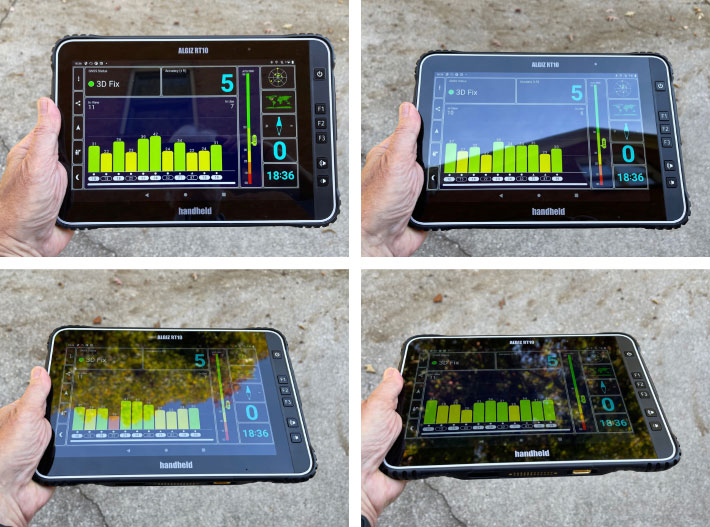
Overall, the RT10 display offers what tablet users expect from a good screen today. It's bright enough, very vibrant, and very sharp. Like most glossy capacitive touch displays, the Algiz RT10 is prone to fingerprints and other smudging. Overall, however, given the current state of display technology, this is an altogether excellent screen.
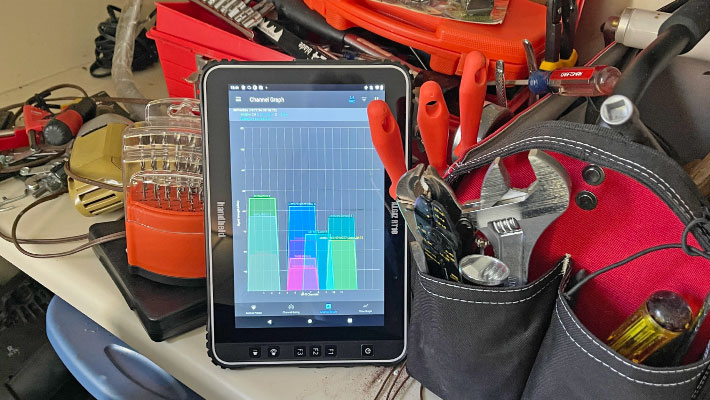
Tough and rugged for the field
As far as ruggedness goes, in its news release materials announcing the Algiz RT10 Handheld said that "it would be tough to outperform the ruggedness of this IP67-rated tablet." And the tablet lives up to that with a very wide operating temperature range from -4 to 140 degrees Fahrenheit (-20 to 60 Celsius). It carries IP67 sealing where the "6" means the computer is totally protected from dust, and the "7" that it can handle even total immersion in water down to about a meter (3.3 feet). 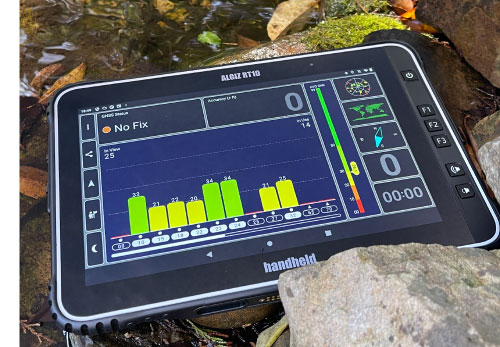 The Algiz RT10 also passed the MIL-STD-810G 516.6. Procedure IV test of 26 drops from a height of four feet to concrete. What does all this mean?
The Algiz RT10 also passed the MIL-STD-810G 516.6. Procedure IV test of 26 drops from a height of four feet to concrete. What does all this mean?
As far as operating temperature goes, the device can be used in most environments where someone would be expected to work with a computer. The folks at the Handheld Group's native Sweden know a thing or two about ice and snow and working in the cold, so we're sure they have low temperature suitability covered.
Ample protection and cushioning make the unit immune to damage from drops from four feet (and we think it can likely handle more), which is about the height it may fall while being used in a standing position. Here, the Algiz RT10's relatively modest weight and the protective all-around bumpers provide excellent shock resistance.
We criticized Handheld's smaller RT7 tablet for not having an IP67 rating because we think that degree of protection is increasingly expected in small mobile computing devices, be they smartphones or tablets. We feel that an IP67 ingress protection rating gives field workers the degree of confidence in their devices that they need on the job. No one uses a tablet to work underwater, but it's quite possible that it may accidentally drop into a creek or big puddle, and then it's really good to know that won't be the end of the device.
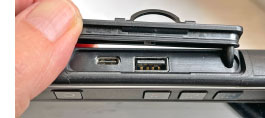 The Algiz RT10's wired interface ports are protected by press-in port covers secured to the tablet with short, thick rubber lanyards. The covers are easy to open via small hinged metal loops, but they are somewhat difficult to securely push/fit into place. The Algiz RT10's wired interface ports are protected by press-in port covers secured to the tablet with short, thick rubber lanyards. The covers are easy to open via small hinged metal loops, but they are somewhat difficult to securely push/fit into place.
Vibration resistance is necessary because Algiz RT10 tablets may well see duty mounted in vehicles, and so Handheld tested the tablet as described in MIL-STD-810G, Method 514.6, Procedures I & II, for general vibration in a fixed mounting and a loose cargo test.
The Algiz RT10 can handle operating altitudes up to 15,000 feet, and was tested according to MIL-STD-810G, Method 507.5 for humidity resistance.
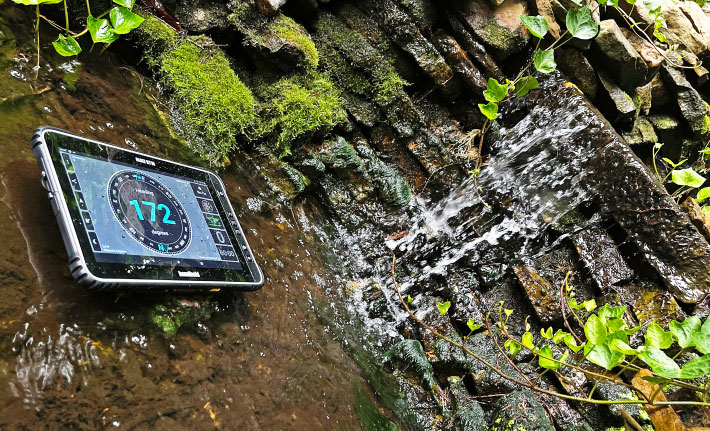
While some customers will probably want to see actual lab reports with more specific detail, the overall impression of the Algiz RT10 is that it's indeed a very rugged device that will likely be able to handle a good deal of abuse. Handheld generally makes ruggedness certificates of compliance available for viewing and downloading, and will likely soon have one for the Algiz RT10 as well. It'd also be good to know the type and version of the hardened glass used in the device.
The Algiz RT10 RTK version
The Algiz RT10 is also available in a special Algiz RT10 RTK version (why not just RTK10?). RTK stands for Real Time Kinematic and is used when the already amazingly good location accuracy of modern positioning systems isn't quite good enough. Standard satellite positioning looks at the time difference between signal receipt from multiple satellites. That's generally good enough for accuracy between three and 13 feet or so — plenty good enough for navigation, general location of destinations, and many other applications. But not good enough for tasks such as land or hydrographic surveys or anything else where sub-meter — better (or much better) than three feet — accuracy is mandatory.
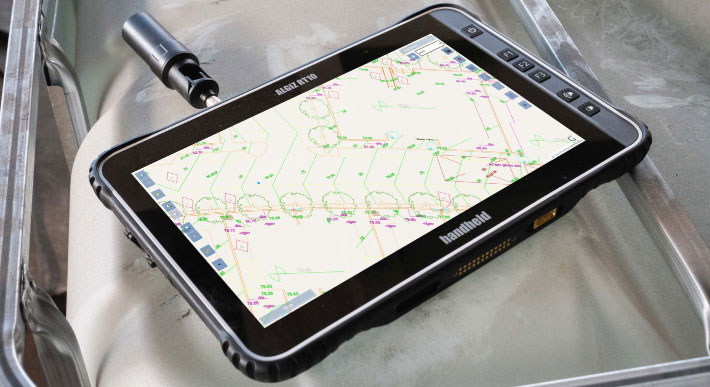
Real Time Kinematic positioning works by not only using satellites, but also a base station and a "rover." The static base station compares the location satellites say it is and then compares that to its actual accurate location. The base station compares the two and then generates a correction factor which is transmitted to the rover. The rover uses that correction signal to more closely determine its own location, reaching accuracy as close as a few inches.
The technology difference between the standard Algiz RT10 and the Algiz RT10 RTK is that the former uses a 72-channel u-blox NEO-M8U GNSS receiver module (see here) and the Algiz RT10 RTK a 184-channel u-blox ZED-F9P high-precision GNSS receiver (see here) with an active multi-band antenna. In terms of performance, we'd expect the RTK version to acquire satellites more quickly, and likely offer very noticeable accuracy advantages both with and without RTK correction.
Summary: Handheld Algiz RT10
The Algiz RT10 is the perfect next logical step in the Handheld Group's lineup. The company's tablet customers now have their choice not only of two compact rugged Windows tablets, but also two industrial strength Android tablets. And with the Algiz RT10, the Handheld Group now has a strong contender in the increasingly important segment of fully rugged 10-inch Android tablets. Why is that important? 
For one thing, VDC Research recently reported that "the most demanded display size across all verticals in the rugged tablet market is between 10" and 12" because that range offers the ideal form factor for portability as well as data capture and reporting workflows in the field.
For another, the Algiz RT10 is eminently practical. Unlike most smartphones and many consumer tablets that you can barely touch without inadvertently triggering some action on the screen, the Algiz RT10 has a nice bezel margin around its display. You can comfortably hold this tablet. The tablet's physical buttons can make it easier to operate than touch alone. And despite its slender profile, the Algiz RT10 is sturdy and solid; you never feel it needs to be babied. In terms of performance, the Algiz RT10 is right at the forefront of today's major rugged 10-inch tablets.
The 10.0-inch daylight-viewable capacitive multi-touch display with its 1920 x 1200 pixel resolution is crisp, bright, and sharp. It offers perfect viewing from all angles, without any color, hue or contrast shifts whatsoever. Like almost all glossy capacitive touch displays it's prone to reflections, but overall this is an excellent display that's very pleasant to use and work on.
The Algiz RT10 is tough enough for use in almost any environment, it is well protected against impact, and it is largely immune to scratching. Like most non-Windows tablets, onboard wired connectivity is fairly limited, here to a USB Type-C port, two USB Type A ports, and an audio jack; everything else (LAN, USB, HDMI, etc.) is done via dock. There is fast 802.11ac dual-band WiFi, WWAN, Bluetooth 5.1, a powerful externally accessible battery, concurrent dedicated GNSS, a full complement of sensors, and an interface to bolt-on expansion modules.
In summary, the new Handheld Algiz RT10 meets the needs of anyone who's been looking for a modern, and very compact 10-inch Android tablet for work even under the most demanding environmental conditions. -- Conrad H. Blickenstorfer, November 2022
|
Handheld Group Algiz RT10 Specifications
|
| Status |
Added 09/2022, full review 11/2022
|
| Type |
Rugged Android tablet
|
| Processor |
Octa-core Qualcomm Snapdragon 480 SM4350 |
| Processor speed |
2.00GHz |
| OS |
Android 11 (GMS)
|
| Graphics |
Adreno 619 |
| Memory |
6GB |
| Display type |
Sunlight-readable TFT LCD with hardened glass |
| Display resolution |
10.0" (1920 x 1200 pixel, 16:10 aspect ratio) 226 ppi, 600 nits, 582 nits as tested |
| Digitizer/Pens |
10-point capacitive multi-touch (incl. rain and glove modes)
|
| Buttons |
Power, F1, F2, F3, volume up/down |
| Storage |
128GB |
| Expansion |
1 x Micro SDXC, 2 x Nano SIM |
| Housing |
Polymer plastic with protective rubber bumpers |
| Operating temperature |
-4 to 140 degrees Fahrenheit (-20 to 60 degrees centigrade) |
| Drops/shock |
26 drops from 1.2 m (4 ft) MIL-STD-810G, Method 516.6 Procedures IV
|
| Vibration |
MIL-STD-810G, Method 514.6 Procedure I
|
| Enclosure Class |
IP67, MIL-STD-810G, IEC 60529 |
| Altitude |
4572 m (15.000 ft)
MIL-STD-810G, Method 500.5 Procedures I & II |
| EMC/EMI |
MIL-STD-461F: CE101, CE102, CS101, CS114, CS115, CS116, RE101, RE102, RS101, RS103 |
| Hazardous materials |
unknown |
| Size |
10.8 x 7.3 x 0.67 inches (274 x 185 x 17 mm) |
| Weight |
2.2 pounds (980 grams)
|
| Power |
User-accessible, field-replaceable 3.8V 11,700mAh 44.46 watt-hour Li-Ion battery
|
| Camera |
5.0 MP (front), 13.0 MP with LED flash (rear)
|
| Sensors |
Ambient light, accelerometer, gyro, fingerprint
|
| Communication |
802.11a/b/g/n/ac, Bluetooth v5.1, integrated u-blox NEO M8U GNSS (GPS, GLONASS, Galileo, BeiDou, QZSS, SBAS), NFC, UHF RFID, 4G LTE, 5G (N41, N78, N79)
|
| Interface |
1 x Qualcomm QuickCharge USB Type-C OTG, 2 x USB 3.0 Type-A, 1 x 3.5mm audio in/out, power, docking connector (supporting HDMI, Ethernet, USB ?????), expansion connector in back
|
| Price |
Starting at US$1,499
|
| Spec sheet |
 Algiz RT10 product brochure (PDF) Algiz RT10 product brochure (PDF) |
| Web page |
Handheld Group Algiz RT10 product page |
| Contact |
Handheld Group AB
Strandgatan 40
531 60 Lidköping, Sweden
Tel: +46 (0) 510 54 71 70
Web: www.handheldgroup.com
Email: info @ handheldgroup.com
HHCS Handheld USA Inc.
2121 NE Jack London Street Suite 100
Corvallis, OR 97330, USA
Tel: (541) 752-0313
Web: www.handheld-us.com
Email: info @ handheld-us.com
|
(copyright 2022 RuggedPCReview.com)
|
|
|









 Desktops, however, are one thing and mobile devices another. When the first PDAs and little Windows CE devices emerged in the 1990s, neither were very successful. PDA screens then shrank down to 3.8 and even 3.5 inches, which worked for small connected organizers and communicators like the Palm Pilot and Blackberry devices. But by that time the web had emerged and handhelds faced a new challenge: how to get web content onto those little screens. There were mobile browsers but they barely worked.
Desktops, however, are one thing and mobile devices another. When the first PDAs and little Windows CE devices emerged in the 1990s, neither were very successful. PDA screens then shrank down to 3.8 and even 3.5 inches, which worked for small connected organizers and communicators like the Palm Pilot and Blackberry devices. But by that time the web had emerged and handhelds faced a new challenge: how to get web content onto those little screens. There were mobile browsers but they barely worked.





 Unlike the battery in Handheld's Windows 10-based Algiz 8X where the battery is part of the design and there is no battery compartment cover, the Algiz RT10 battery does require a cover that has an orange silicone pressure seal around its entire perimeter. That cover is secured with four Torx T6 screws, so this design isn't meant for quick battery exchanges on the fly; you do need a screw driver.
Unlike the battery in Handheld's Windows 10-based Algiz 8X where the battery is part of the design and there is no battery compartment cover, the Algiz RT10 battery does require a cover that has an orange silicone pressure seal around its entire perimeter. That cover is secured with four Torx T6 screws, so this design isn't meant for quick battery exchanges on the fly; you do need a screw driver.


 that was introduced in 2021. This chip should offer about twice the performance of the Snapdragon 625 used in Handheld's smaller Algiz RT8, and generally be as quick or quicker than the Snapdragon 660 that's currently found in most high-end rugged Android devices. Qualcomm describes the SD 480 as a 5G Mobile Platform that supports multiple 5G spectrums, dual-antenna Wi-Fi, and also includes the powerful Adreno 619 GPU.
that was introduced in 2021. This chip should offer about twice the performance of the Snapdragon 625 used in Handheld's smaller Algiz RT8, and generally be as quick or quicker than the Snapdragon 660 that's currently found in most high-end rugged Android devices. Qualcomm describes the SD 480 as a 5G Mobile Platform that supports multiple 5G spectrums, dual-antenna Wi-Fi, and also includes the powerful Adreno 619 GPU.






 That said, resolution alone isn't everything, especially not with displays that are often, or predominantly, used outdoors and in broad daylight. It's one thing for a display to look good indoors, and quite another doing so outdoors with its much higher brightness, the sun, and reflections everywhere.
That said, resolution alone isn't everything, especially not with displays that are often, or predominantly, used outdoors and in broad daylight. It's one thing for a display to look good indoors, and quite another doing so outdoors with its much higher brightness, the sun, and reflections everywhere.


 The Algiz RT10 also passed the MIL-STD-810G 516.6. Procedure IV test of 26 drops from a height of four feet to concrete. What does all this mean?
The Algiz RT10 also passed the MIL-STD-810G 516.6. Procedure IV test of 26 drops from a height of four feet to concrete. What does all this mean?
 The Algiz RT10's wired interface ports are protected by press-in port covers secured to the tablet with short, thick rubber lanyards. The covers are easy to open via small hinged metal loops, but they are somewhat difficult to securely push/fit into place.
The Algiz RT10's wired interface ports are protected by press-in port covers secured to the tablet with short, thick rubber lanyards. The covers are easy to open via small hinged metal loops, but they are somewhat difficult to securely push/fit into place.



